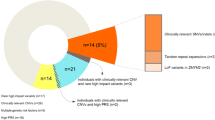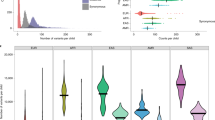Abstract
Reduced fecundity, associated with severe mental disorders1, places negative selection pressure on risk alleles and may explain, in part, why common variants have not been found that confer risk of disorders such as autism2, schizophrenia3 and mental retardation4. Thus, rare variants may account for a larger fraction of the overall genetic risk than previously assumed. In contrast to rare single nucleotide mutations, rare copy number variations (CNVs) can be detected using genome-wide single nucleotide polymorphism arrays. This has led to the identification of CNVs associated with mental retardation4,5 and autism2. In a genome-wide search for CNVs associating with schizophrenia, we used a population-based sample to identify de novo CNVs by analysing 9,878 transmissions from parents to offspring. The 66 de novo CNVs identified were tested for association in a sample of 1,433 schizophrenia cases and 33,250 controls. Three deletions at 1q21.1, 15q11.2 and 15q13.3 showing nominal association with schizophrenia in the first sample (phase I) were followed up in a second sample of 3,285 cases and 7,951 controls (phase II). All three deletions significantly associate with schizophrenia and related psychoses in the combined sample. The identification of these rare, recurrent risk variants, having occurred independently in multiple founders and being subject to negative selection, is important in itself. CNV analysis may also point the way to the identification of additional and more prevalent risk variants in genes and pathways involved in schizophrenia.
This is a preview of subscription content, access via your institution
Access options
Subscribe to this journal
Receive 51 print issues and online access
$199.00 per year
only $3.90 per issue
Buy this article
- Purchase on Springer Link
- Instant access to full article PDF
Prices may be subject to local taxes which are calculated during checkout

Similar content being viewed by others
Change history
11 September 2008
The AOP version of this paper carried incorrect affiliations for 'Genetic Risk and Outcome in Psychosis' group. This was corrected for print on 11 September 2008.
References
Vogel, H. P. Fertility and sibship size in a psychiatric patient population. A comparison with national census data. Acta Psychiatr. Scand. 60, 483–503 (1979)
Weiss, L. A. et al. Association between microdeletion and microduplication at 16p11.2 and autism. N. Engl. J. Med. 358, 667–675 (2008)
Shifman, S. et al. Genome-wide association identifies a common variant in the reelin gene that increases the risk of schizophrenia only in women. PLoS Genet. 4, e28 (2008)
Lu, X. et al. Clinical implementation of chromosomal microarray analysis: summary of 2513 postnatal cases. PLoS ONE 2, e327 (2007)
de Vries, B. B. et al. Diagnostic genome profiling in mental retardation. Am. J. Hum. Genet. 77, 606–616 (2005)
Millar, J. K. et al. Disruption of two novel genes by a translocation co-segregating with schizophrenia. Hum. Mol. Genet. 9, 1415–1423 (2000)
Sharp, A. J. et al. Discovery of previously unidentified genomic disorders from the duplication architecture of the human genome. Nature Genet. 38, 1038–1042 (2006)
Walsh, T. et al. Rare structural variants disrupt multiple genes in neurodevelopmental pathways in schizophrenia. Science 320, 539–543 (2008)
Ni, X. et al. Connexin 50 gene on human chromosome 1q21 is associated with schizophrenia in matched case control and family-based studies. J. Med. Genet. 44, 532–536 (2007)
Brzustowicz, L. M., Hodgkinson, K. A., Chow, E. W., Honer, W. G. & Bassett, A. S. Location of a major susceptibility locus for familial schizophrenia on chromosome 1q21-q22. Science 288, 678–682 (2000)
Gurling, H. M. et al. Genomewide genetic linkage analysis confirms the presence of susceptibility loci for schizophrenia, on chromosomes 1q32.2, 5q33.2, and 8p21–22 and provides support for linkage to schizophrenia, on chromosomes 11q23.3–24 and 20q12.1–11.23. Am. J. Hum. Genet. 68, 661–673 (2001)
Hwu, H. G., Liu, C. M., Fann, C. S., Ou-Yang, W. C. & Lee, S. F. Linkage of schizophrenia with chromosome 1q loci in Taiwanese families. Mol. Psychiatry 8, 445–452 (2003)
Zheng, Y. et al. A two-stage linkage analysis of Chinese schizophrenia pedigrees in 10 target chromosomes. Biochem. Biophys. Res. Commun. 342, 1049–1057 (2006)
Murthy, S. K. et al. Detection of a novel familial deletion of four genes between BP1 and BP2 of the Prader-Willi/Angelman syndrome critical region by oligo-array CGH in a child with neurological disorder and speech impairment. Cytogenet. Genome Res. 116, 135–140 (2007)
Rogers, S. J., Wehner, D. E. & Hagerman, R. The behavioral phenotype in fragile X: symptoms of autism in very young children with fragile X syndrome, idiopathic autism, and other developmental disorders. J. Dev. Behav. Pediatr. 22, 409–417 (2001)
Dimitropoulos, A. & Schultz, R. T. Autistic-like symptomatology in Prader-Willi syndrome: a review of recent findings. Curr. Psychiatry Rep. 9, 159–164 (2007)
Nowicki, S. T. et al. The Prader-Willi phenotype of fragile X syndrome. J. Dev. Behav. Pediatr. 28, 133–138 (2007)
Borghgraef, M., Fryns, J. P. & van den Berghe, H. The female and the fragile X syndrome: data on clinical and psychological findings in 7 fra(X) carriers. Clin. Genet. 37, 341–346 (1990)
Thompson, N. M. et al. Neurobehavioral characteristics of CGG amplification status in fragile X females. Am. J. Med. Genet. 54, 378–383 (1994)
Hancock, M. L., Canetta, S. E., Role, L. W. & Talmage, D. A. Presynaptic type III neuregulin1-ErbB signaling targets α7 nicotinic acetylcholine receptors to axons. J. Cell Biol. 181, 511–521 (2008)
Freedman, R. et al. Linkage of a neurophysiological deficit in schizophrenia to a chromosome 15 locus. Proc. Natl Acad. Sci. USA 94, 587–592 (1997)
Erdogan, F. et al. Characterization of a 5.3 Mb deletion in 15q14 by comparative genomic hybridization using a whole genome “tiling path” BAC array in a girl with heart defect, cleft palate, and developmental delay. Am. J. Med. Genet. A 143, 172–178 (2007)
Fernandes, C., Hoyle, E., Dempster, E., Schalkwyk, L. C. & Collier, D. A. Performance deficit of α7 nicotinic receptor knockout mice in a delayed matching-to-place task suggests a mild impairment of working/episodic-like memory. Genes Brain Behav. 5, 433–440 (2006)
Karayiorgou, M. et al. Schizophrenia susceptibility associated with interstitial deletions of chromosome 22q11. Proc. Natl Acad. Sci. USA 92, 7612–7616 (1995)
Murphy, K. C. Schizophrenia and velo-cardio-facial syndrome. Lancet 359, 426–430 (2002)
Lee, J. A., Carvalho, C. M. & Lupski, J. R. A. DNA replication mechanism for generating nonrecurrent rearrangements associated with genomic disorders. Cell 131, 1235–1247 (2007)
Bieche, I. et al. Novel approach to quantitative polymerase chain reaction using real-time detection: application to the detection of gene amplification in breast cancer. Int. J. Cancer 78, 661–666 (1998)
The International Schizophrenia Consortium. Rare chromosomal deletions and duplications increase risk of schizophrenia. Nature 10.1038/nature07239 (this issue)
Colella, S. et al. QuantiSNP: an objective Bayes Hidden-Markov Model to detect and accurately map copy number variation using SNP genotyping data. Nucleic Acids Res. 35, 2013–2025 (2007)
Conrad, D. F., Andrews, T. D., Carter, N. P., Hurles, M. E. & Pritchard, J. K. A high-resolution survey of deletion polymorphism in the human genome. Nature Genet. 38, 75–81 (2006)
Hastie, T. & Tibshirani, R. Generalized additive models. Stat. Sci. 1, 297–310 (1986)
Acknowledgements
We want to thank the subjects and their relatives and staff at the recruitment centres. This work was sponsored by EU grant LSHM-CT-2006-037761 (Project SGENE), Simons Foundation and R01MH71425-01A1. Genotyping of the Dutch samples was sponsored by NIMH funding, R01 MH078075. This work was also supported by the Chinese National Natural Science Foundation and the National Genomic Network (NGFN-2) of the German Federal Ministry of Education and Research (BMBF). M.M.N. received support from the Alfried Krupp von Bohlen und Halbach-Stiftung. We are grateful to S. Schreiber and M. Krawczak for providing genotype data for PopGen controls, and to K.-H. Jöckel and R. Erbel for providing control individuals from the Heinz Nixdorf Recall Study. We thank L. Priebe and M. Alblas for technical assistance and analysis of CNV data from Bonn.
Author Contributions H.S., D.R., E.S., D.C., L.P., D.S.C. and K.S. wrote the first draft of the paper. M.H., B.B.M., K.D.J., P.M., I.G., H.-J.M., A.H., A.C.N., C.C., G.F., N.W., J.L., J.S., A.T., T.T., E.B., M.D.F., R.M., M.R, S.T., M.W., T.L., C.V., T.W.M., A.G.W., H.U., S.D., I.M., J.O., O.A.A., A.G., M.R., R.O., J.B., R.S.K., L.A.K. and B.F. recruited, diagnosed and gathered phenotypes. H.S., D.R., R.F., E.S., T.S., C.F., P.M., T.T, J.R.G., U.T., H.P., D.G., T.W., D.C., L.P., D.S.C. and K.S. planned, supervised and coordinated the work. H.S., S.C., A.I., S.S., A.G., T.E.T., O.P.H.P., B.V.H., D.G., K.V.S., M.M.N., T.H. and A.K. analysed the data. A.S., A.J., A.J., A.B., S.M. and T.B. performed genotyping and experimental work. All authors contributed to the current version of the paper.
Author information
Authors and Affiliations
Consortia
Corresponding authors
Ethics declarations
Competing interests
K.S. and J.R.G. are CEO and CSO, respectively, of deCODE genetics and hold equity positions in the company.
Additional information
The authors declare competing financial interests: details accompany the full-text HTML version of the paper at www.nature.com/nature.
Lists of authors and affiliations appear at the end of the paper.
Supplementary information
Supplementary Information 1
This file contains Supplementary Notes, Supplementary Tables 1-9, Supplementary Figures 1-4 and additional references. (PDF 1409 kb)
PowerPoint slides
Rights and permissions
About this article
Cite this article
Stefansson, H., Rujescu, D., Cichon, S. et al. Large recurrent microdeletions associated with schizophrenia. Nature 455, 232–236 (2008). https://doi.org/10.1038/nature07229
Received:
Revised:
Accepted:
Issue Date:
DOI: https://doi.org/10.1038/nature07229
This article is cited by
-
Nexus between genome-wide copy number variations and autism spectrum disorder in Northeast Han Chinese population
BMC Psychiatry (2023)
-
SREBP modulates the NADP+/NADPH cycle to control night sleep in Drosophila
Nature Communications (2023)
-
Sequence variants affecting the genome-wide rate of germline microsatellite mutations
Nature Communications (2023)
-
Developmental mechanisms underlying the evolution of human cortical circuits
Nature Reviews Neuroscience (2023)
-
No signs of neurodegenerative effects in 15q11.2 BP1-BP2 copy number variant carriers in the UK Biobank
Translational Psychiatry (2023)
Comments
By submitting a comment you agree to abide by our Terms and Community Guidelines. If you find something abusive or that does not comply with our terms or guidelines please flag it as inappropriate.



